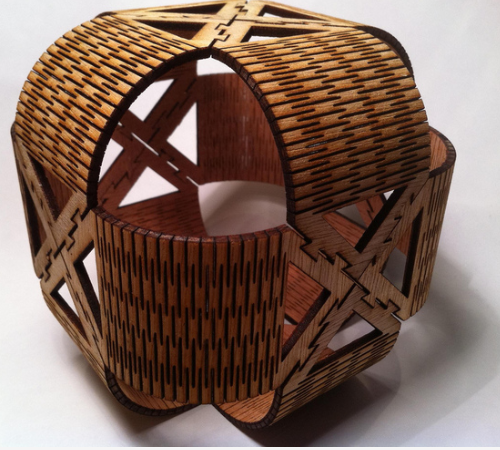Laser Cutter Example: “Modular Ornament” by Tim Hudson (2011)
 Tim Husdon uses two techniques to join the toy or modular ornament. He uses Snijlab Living hinge design.
Tim Husdon uses two techniques to join the toy or modular ornament. He uses Snijlab Living hinge design.
 Tim Husdon uses two techniques to join the toy or modular ornament. He uses Snijlab Living hinge design.
Tim Husdon uses two techniques to join the toy or modular ornament. He uses Snijlab Living hinge design.
Ghassaei has used various materials to make record, in her most recent project she has used sheets of maple wood in which a laser cutter makes the grooves for a music track. Only about one song can fit on each side of the 12 in sheet because of the thickness of the laser beam. Listening to the final product really completes the project as art.
Basia Smolnicki’s “Possession” is a laser cut wood block print with gold pigment. When the shapes were successfully carved out of the wood block, the work was painted through a use of roller to completely color up the “negative space” between the designs.
A sculptor and an installation artist, Michael Snape, uses stainless or painted steel to create abstract forms and silhouettes. His “Corrdior” is assembled with pieces of painted steel, cut by a laser cutter.
Elvira ‘t Hart aims to make “wearable drawings” by utilizing laser cutter technique with her original sketches. By using digital technology, she is able to copy her “signature” exactly, by producing the same lines that she designed beforehand.
Everyone grabs a cuff when they buy coffee, but Sweeney decided to make attractive, reusable plywood cuffs. The cuff bends because the creator used laser Kerf-bending. He cut slits and designs into the plywood which reduced the closed surface area and made the wood more flexible.
These pieces are created by turning 3D images into unfolded 2D polygons and then laser printing them on fabric. The polygons are then sewn together. Though these steps create a digital twin of the original 3D image, they also allow the viewer to see in a different way.
This project uses a laser cutter on bread to create the perfect PB&J sandwich. This piece has four layers all with deep cuts so that the sandwich can be pulled apart; the bottom layer has shallow cuts to create a toast pattern and deeper cuts for the pull away sections, the next layer has compartments for jelly, the following layer has compartments for PB, and the top layer has shallow “toast” lines and lines to show the order to eat the sandwich in.